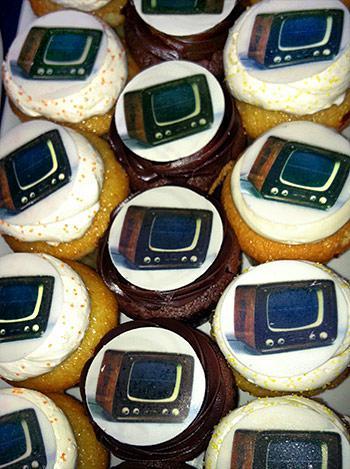
Cupcakes decorated with Nam June Paik's Zen for TV
Long before there was YouTube and social media, there was Nam June Paik who said, "Someday everybody will have his own TV channel." Paik, who was born in Korea, and spent time in Europe before settling in New York, would have turned 80 on July 20. To honor the artist who would have been happy to let us all "think inside the box," American Art celebrated with a few speakers who knew Paik well, before ending with cupcakes that were decorated with an image of one of Paik's iconic works: Zen for TV. We gathered in the Lincoln Gallery, on the third floor of the museum, in front of Paik's larger-than-life Electronic Superhighway: Continental U.S., Alaska, Hawaii.
"There's no better place to honor Paik than in front of one of his most celebrated works," said John Hanhardt, senior curator for media arts. Paik's longtime friend and the driving force behind the museum's acquisition of the artist's archives, Hanhardt remembered seeing Electronic Superhighway at the Holly Solomon Gallery in New York City in 1995. Even from outside the gallery on Hudson Street, the work compelled. According to Hanhardt, this "dynamic and playful map" shows the artist's signature editing and image processing, in which he used TV and news events from popular media and from such cultural icons as The Wizard of Oz. For Paik, television became a form of creative expression. "He was the most original thinker I ever met," added Hanhardt.
The next speaker was Kota Ezawa, who was recently represented by one of his own works in the exhibition, Watch This! New Directions in the Art of the Moving Image. Ezawa spoke of interactions with Paik as a teacher and mentor in Germany in the mid 1990s. He described him as "a little laid back in his teaching, who didn't show up all that often," but when he did, it was life-changing. "One day he took us to a casino, gave us each about 50 Deutsche Mark, and said, 'Good luck.'" As Ezawa said, "To make art is a really huge gamble, so it was quite a lesson we learned that evening." With Paik, invention seemed endless. Anything could be a TV. Paik once told him, "The moon is a television," having created The Moon is the Oldest TV, a multi-monitor installation in 1965. Ezawa then showed us a "television" he made from an empty box that once contained chocolate powder (he made his first chocolate powder television when he was ten). He cut the box to form his own TV, displaying images that moved when you turned a wooden cooking spoon. Inside, was a drawing of one of Paik's signature Buddha works, followed by a drawing of Paik playing the piano for his students in Dusseldorf.
Ken Hakuta, Paik's nephew, was the last speaker of the evening. He shared some childhood stories with us about the man he referred to "my crazy uncle." Paik told Ken's mother that her son needed to watch more television, and that he should have a better TV! Apparently, that worked. (Kids, are you listening?) As a young boy, Hakuta took piano lessons but was a self-described "bad piano student." Nam June came to their house one day and borrowed the piano for one of his performances, which got destroyed in the process. "So that was the end of my piano lessons," Hakuta added. "I owe a lot to my crazy uncle, Nam June," he said. Somehow, I think we all do.
In honor of Paik's birthday, and in anticipation of American Art's upcoming exhibition of Paik's work Nam June Paik: Global Visionary, the evening ended with Zen for TV-inspired cupcakes. So, move over moon. The cupcake is a television, too.

